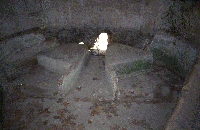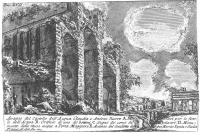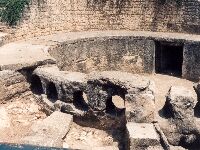


Castellum divisorium
also called: castellum aquaeThere is evidence that water quality was an issue in antiquity. All that was needed to filter the water was essentially a large tank where the speed of the current would be sufficiently retarded for the impurities in suspension to settle to the bottom. More elaborate filtration methods where also used. For example, a castellum might have two chambers set at different levels. The water would arrive in the lower chamber and leave from the upper chamber. At Cirta in Algeria a filter made of sandbags was used, though nothing like this has been found in Rome.
A castellum - there are 247 known castella in Rome (Hodge, 2002:291, see under basin) - was also built where the water was channelled to public users. As the number of aqueducts increased, favoured individuals were granted private supplies; water was diverted to their private residences. Although most castella belonged to the state, when enough private users existed to justify it, and they could afford it, they could build a private castellum at a location approved by a waterworks inspector (Hodge, 2002:294). Once collected in the distribution tank, the water was carried out to various places through lead or tile pipes (fistulae), which were connected to the castellum via what was called a calix, see illustration, a pipe with fixed diameter, often made of bronze. Fistulae transported water to many facets of the city; private, public and imperial. An interesting phenomenon, regarding the distribution tank, is the description from Vitruvius' treatise (8.6.1-2) regarding the surplus of water, often wrongly interpreted as a system of hierarchy favouring water for public use:
When it [the water] has reaches the walls of the city, build a reservoir (castellum aquae) and adjoining the reservoir a three-part reservoir compartments connected with the reservoir to receive the water. Within the reservoir lay three systems of pipes, one for each of the connecting tanks, so that when the water runs over from the tanks at the ends, it may run into the central tank. The piping system for all the public pools and running fountains should be put in the middle tank; pipes for the baths in one of the outside tanks, to provide tax revenue every year for the people of Rome; and in the third tank the piping system should be directed to private homes, so that there will never be a shortage of public water for private citizens will not be inclined to divert public supplies if they have their own supply from the same source.There was a water tax, and this was determined by the size of the calix that was connected to the distribution tank. A premium was charged for many private deliveries.
From the thesis of Evan J. Dembskey on The aqueducts of Ancient Rome